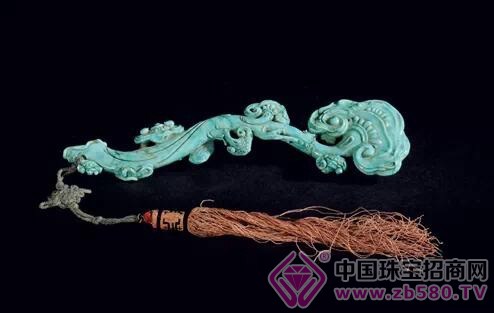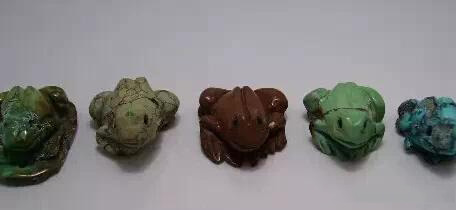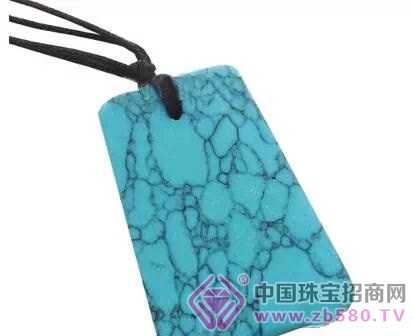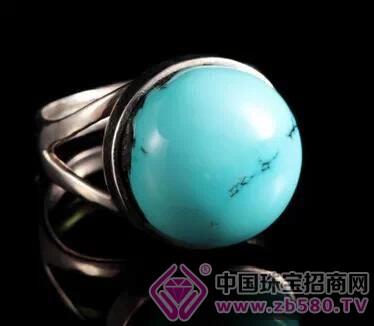Speaking from turquoise blue
The blue color of turquoise given by the foreign gemstones is of great significance. In many of the introductions to turquoise, the meaning of the blue of turquoise is mentioned in the evaluation. I personally also like to represent the sky and the ocean, symbolizing the tranquility and the vast turquoise blue. In the main producing area of ​​China's turquoise, it is called the "day, lake blue" color. In the foreign materials, the records of the royal and nobles wearing blue turquoise are common, while in China, there are many materials with green turquoise as royal ornaments. Turquoise is named in China because it is "shaped like a pine ball, and its color is nearly pine green."

Turquoise is a self-made gemstone. Because of the different proportions of the coloring trace elements contained in the interior, the colors are different. When the inside of the gemstone contains a large amount of copper oxide, it is blue; when the iron-containing oxide is mostly green, when it contains a lot of divalent iron, it is yellow or brown. Turquoise has the reputation of “five-colored stones†in its place of origin. It can be divided into five categories: blue, green, brown, yellow and white. There are hundreds of differences. The color does not affect the texture of the turquoise and should not be of primary importance in the evaluation.
The dense and pure "day, lake blue", "pine, fruit green", "rapeseed yellow", "rust iron red", etc., are very rare, of which "the rapeseed yellow" color is better than "day, lake blue" The "pine, fruit green" color is even rarer. Just choose your personal preference for color.
The evaluation of turquoise should be based primarily on its texture, block size and process. The international jewellery industry divides turquoise into four major grades: first grade (Persian), second grade (American grade), third grade (Egypt), and fourth grade (Afghanistan), which does not have a place of origin. (Not much to introduce here). First-class products are of the highest quality. There is information on zinc turquoise (a kind of transparent turquoise), which is extremely rare. There is no more than one carat after the honing.
2, on the classification of turquoise

In China, turquoise is generally divided into textures: porcelain pine, iron wire porcelain pine, hard pine and pine or pine.
Porcelain pine
The ore body is tightly combined, the texture is fine, the color is uniform, and the block size is small. After being cut and polished, it can present the texture and luster of porcelain, and the color is beautiful. Finished products over 50 grams are extremely rare.
Iron wire porcelain pine
The characteristics of the ore body and the cutting and polishing are basically the same as those of the porcelain pine, but the gemstone contains a black or maroon texture closely combined with the gemstone, which is called iron wire. The finer and clearer iron wire is the top grade. Because the finished product can be processed with surrounding rock, it can be seen that the block size is large. Those over 300 grams are also rare.
The above two categories are used as gem-quality turquoise, and the output is scarce and highly collectible. The same level of finished products without inlays can produce a crisp and pleasing porcelain impact sound when they collide with each other slightly. When purchasing finished products, the color should be uniform, the gloss is high, the craft is fine, the block is large, and the value is high. Such genuine products in the market can be called "rare".
Hard pine
The output of general mining areas is mostly such. The combination of ore bodies is relatively compact, the texture is relatively delicate, the color is rich, and the blockiness is uneven. After being cut and polished, it gives oil and wax texture and luster, and the color is soft. The color uniformity also includes iron wire and piebald turquoise. The main difference is in the block degree. The color is uniform, and the finished product is more than 1000 grams. There are also treasures of 2000-5000 grams, which are extremely rare. The iron wire and the spotted turquoise stone are relatively large, and the finished product is more than 3000 grams. It can also be seen that 5-10 kg, even 20-30 kg, is rare, and more than just surface cutting and polishing, as a gemstone ore body to watch and collect, it has great potential for appreciation.
This type of jewelry is turquoise, the raw material output is relatively rich, the product range is complete, and the price difference is large. When purchasing finished products, the color and texture should be unique, the surface gloss should be soft, and the block size should be high. The value is high, of course, the process evaluation is also indispensable.
Loose or loose
The ore body combines looseness, soft texture, dull color and a gray-white hue in all colors. After cutting, it has a soily texture and luster, which cannot be polished and has no polishing significance.
This type is jewelry-grade turquoise. After cutting the raw materials, it can be ground into powder. This grade has low hardness, low density and dark color. It must be polished and polished after being poured and dyed. It is processed into jewelry. Not collectible. (2) The price of turquoise is turquoise. Among the four famous jade in China, the known reserves are the least. The price difference with the international jewelry market is nearly 10 times. Therefore, turquoise should have a great appreciation in China.
Naturally produced turquoise is extremely depleted during processing. The raw material without any treatment can only be processed to a yield of 15%-20%, which can be called A cargo. If the yield after perfusion treatment is usually 50%-60%,
Up to 70% - 80%, can be called B goods. There are generally two kinds of perfusion methods: “dip†treatment at normal temperature and atmospheric pressure, and “injection†treatment under normal temperature and high pressure, or collectively, can be processed before gem processing to improve the yield ( Quality). It is also dyed to increase the color (value), which can be called C goods. It is also possible to carry out two processes at the same time, which can be called B+C goods. The process is not covered here. This treatment method has been generally accepted abroad and is not recognized in China. The identification can be distinguished by the "water immersion method" introduced in "Authenticity and Authenticity", which is simple and quick.
In China, there is an ancient, traditionally accepted traditional jade optimization method called “wax waxâ€, “wax wax†or “waxâ€, which is applied in all jade processing technologies. The method is to polish a jade stone after it has been processed into a finished product. The purpose is to retain water, fix the color, and make the gemstone not suitable for being soiled. Should still be a cargo. When using the "water immersion method" to identify, the gems need to be soaked in water for a while (about 1-2 minutes), and there will also be water discoloration.
At present, the turquoise products in the market are mostly B, C and B+C products that have been infused. In the domestic jewellery and jade market, the turquoise A, B, C goods are mixed, and the price crosses. There is no obvious distinction between the jewelry grade and the jewelry grade. It is difficult for consumers to judge the quality by price. The retail price of finished products (excluding additional process and brand value) ranges from RMB 15-80 per gram. In the case of A goods and B goods, the price difference caused by the yield rate should be between 3 and 4 times. There is no obvious price difference between B goods and C goods. The gem-quality turquoise products in the market are “rareâ€, and most merchants will not have A goods “porcelain pineâ€. Generally, it will not be sold according to gram weight, and the value of a single piece is more than one thousand yuan.
3 talk about the wearing of turquoise

When wearing turquoise ornaments for sports and life (such as swimming, bathing, sauna), there is generally no impact on the gemstones. However, the turquoise is porous and the color is delicate. When wearing it, it should be kept away from the colored liquid and the fading items, so as to avoid the penetration of the color into the pores, so that the gem is soaked and difficult to remove.
In the professional testing, it should also be noted that the identification should be used with caution when using the oil (special liquid for detecting the refractive index of the gemstone), avoiding the use of heavy liquid (special liquid for detecting the specific gravity of the gemstone), because tribromomethane, diiodomethane, etc. Stained stones can't be removed.
Attention should be paid to the processing of jewelry. Turquoise is not resistant to high temperatures (above 160 degrees), is not resistant to open flames, and cannot be directly burned to avoid discoloration or even bursting.
Turquoise is a phosphate gemstone that dissolves slowly in acidic (such as hydrochloric acid) liquids, and the surface becomes brownish black and extremely difficult to remove. Avoid contact with acidic materials when wearing and storing.
For the A cargo turquoise jewelry, the best way to maintain it is to wear it for a long time. Usually it will be worn for about three months. It will make your gem "warm and warm" and the color will change significantly. When you need to store for a long time (more than 6 months), just soak the turquoise with warm water until it is cool, then wash and dry. For a short period of time (within 6 months), the stone can be washed and dried, and then coated with a layer of colorless oil (such as glycerin, baby oil, etc.). When worn again, the surface oil will be wiped off. like New.
4 elaborate the turquoise I know

Talk about that 95% of the imitation
Nowadays, the imitation of turquoise is flooding the market. The main imitation is an ore called magnesite, which is a carbonate mineral. In China's Inner Mongolia and other places, there are a large number of output, and the price is low.
After dyeing and filling, it can imitate all kinds of turquoise products. The colors are bright and rich, and the colors are uniform (dyeing, what color is there). Can be worn as an ornament for people to wear, but it does not have the value and meaning of gemstones.
There are several common ones, I think it is simply "plastic", just see the fire.
Then there is glass imitation.
There are also a number of replicas that are relatively expensive. For example, there are products that are pressed with stone powder (not turquoise powder) and sometimes added with some talcum powder to enhance the smooth feel.
More textured, and the texture is clear and smooth.
Let's take a look at the texture of natural turquoise.
Another introduction is called "hydroxysilicate boronite", also known as "soft bauxite", which is a borate mineral. Monoclinic system, common block crystal. After cutting, the surface of the glass is glossy, translucent to opaque. Hardness 3-4. Mainly produced in the Americas.

Some people in the market called it "American White Pine", and the "iron wire" is still grayish after dyeing. There are also cyanite and gibbsite imitation turquoise, but the domestic market is rare, so I will not introduce it.
Silicone Ring Grip Exercisers
Increase strength and improve dexterity with the silicone hand strengthener rings.
Premium silicone rings offer three levels of resistance for gaining strength in the hands, wrists and forearms. The silicone hand strengthener rings are tear-resistant, quiet and odorless and are easily portable in the convenient nylon travel bag. Use to build strength following surgery, as a part of physical therapy or to improve as an athlete or musician.
Silicone Rubber For Molding ,Silicon Liquid Rubber For Molding,Rubber Material For Mold,Molded Rubber Part
Xiamen The Answers Trade Co.,Ltd. , https://www.answerssilicone.com
![<?echo $_SERVER['SERVER_NAME'];?>](/template/twentyseventeen/skin/images/header.jpg)